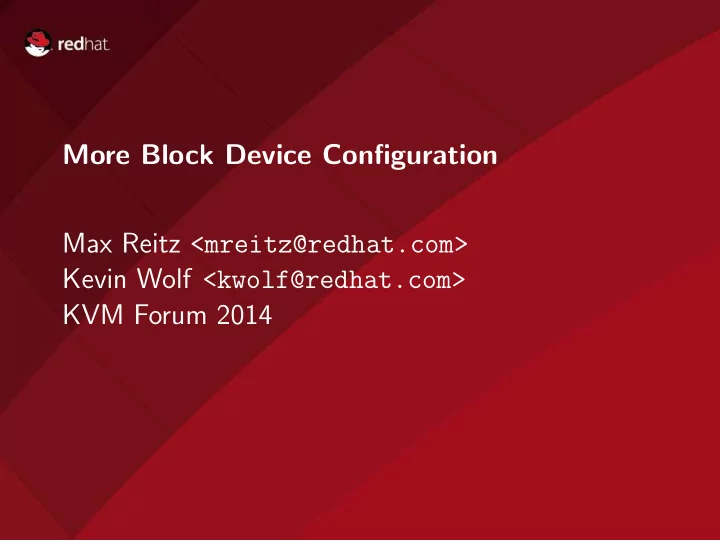

More Block Device Configuration Max Reitz <mreitz@redhat.com> Kevin Wolf <kwolf@redhat.com> KVM Forum 2014
Part I What we have
BlockDriverState BDS
BDS types Protocol Format
Simple BDS tree Guest device IDE qcow2 Format BDS Protocol BDS file
Terminology Frontend IDE (guest device) Backend (BDS qcow2 backing Root tree) qcow2 file http
What is possible today IDE raw file quorum ] c 0 h [ d i l d l h i [ 2 c ] child[1] qcow2 raw qcow2 backing file file file qcow2 blkdebug qcow2 nbd file file file http file nfs
How to configure this? Legacy syntax: -hda nbd:localhost:10809 IDE Separate backend and frontend; Option syntax for backend: raw -drive if=none,\ file id=disk0,driver=raw,\ file.driver=nbd,\ nbd file.host=localhost -device ide-hd,drive=disk0
blockdev-add -drive if=none,id=disk0,driver=raw,\ file.driver=nbd,file.host=localhost { "execute": "blockdev-add", "arguments": { disk0 "options": { raw "id": "disk0", "driver": "raw", file "file": { nbd "driver": "nbd", "host": "localhost" } } } }
What is possible today (again) disk0 "options": { raw "id": "disk0", "driver": "raw", file "file": { quorum child[0] child[2] "driver": "quorum", child[1] "vote-threshold": 2, "children": [ { qcow2 qc1 qc2 "driver": "qcow2", backing file "backing": "back0", "file": "file0", back0 file0 }, "qc1", "qc2" ] } }
node-name vs. id BDS directly connected to guest devices (legacy!) BDS id used to connect both blockdev-add : id ⇐ ⇒ top-level BDS → id ≈ guest-accessible BDS Naming and accessing non-top-level BDS? → node-name Common namespace for id and node-name
Options in filenames, revisited json:{"driver": "qcow2", "cache-size": 0, "file": { "driver": "file", "filename": "file.qcow2" } } Why? Some options cannot be given in filenames (e.g. qcow2 metadata cache size) Sometimes you can only give filenames (e.g. backing file field in COW files)
Part II Some unsolved problems
Section 1 Make everything use blockdev-add
Make everything use blockdev-add Opening block devices (blockdev-add) If you use blockdev-add ... All required options are specified Optional options get defaults We’ll get to the problems there later Building the graph is straightforward
Make everything use blockdev-add Opening block devices (-drive) If you use -drive , we’d like to translate that into a clean blockdev-add , but... Not even the block driver (image format) is required More involved magic to fill in defaults New nodes may be automatically created No specification of this magic exists We need to stay compatible with old versions
Make everything use blockdev-add Inherited options (I) disk [qcow2] Determining cache mode for a single node: 1 Explicitly specified e.g. -drive cache.direct=on 2 Default is cache=writeback
Make everything use blockdev-add Inherited options (II) disk [qcow2] file disk.file [file] Determining cache mode for the protocol level: 1 Explicitly specified 2 Inherit from parent node ( disk ) 3 Default is cache=writeback
Make everything use blockdev-add Inherited options (III) backing disk [qcow2] backing [qcow2] file file disk.file [file] backing.file [nbd] Determining cache mode for the backing file: 1 Explicitly specified 2 Backing file path: json: { cache:... } 3 Inherit from parent node ( disk ) 4 Default is cache=writeback
Make everything use blockdev-add It goes both ways disk [qcow2] existence drive file driver cache disk.file [file] Format probing: Must open protocol layer first Options for protocol depend on format layer Protocol only added by default if format driver requires a protocol
Make everything use blockdev-add It goes both ways Format probing: Must open protocol layer first Options for protocol depend on format layer Protocol only added by default if format driver requires a protocol So we can’t easily translate everything into plain blockdev-add options in a wrapper. �
Section 2 Reopening
Reopening Reopen: The traditional case bdrv reopen(cache=none) backing disk [writeback] backing [writeback] file file disk.file [writeback] backing.file [writeback] Cache mode of backing file wasn’t explicitly configurable: All nodes inherited from the root Reopen affects all nodes
Reopening Reopen: blockdev-add world (I) bdrv reopen(cache=writethrough) backing disk [writeback] backing [none] file file disk.file [writeback] backing.file [none] What happens if the backing file has... ...inherited the cache mode ...an explicitly set cache mode ...got its cache mode from a json: filename
Reopening No inheritance with references backing disk [qcow2] backing [qcow2] file file disk.file [file] backing.file [nbd] Cache mode for a separately created backing file: 1 Explicitly specified 2 Default is cache=writeback Don’t change options when a node is referenced
Reopening Reopen: blockdev-add world (II) bdrv reopen(cache=writethrough) backing disk [writeback] backing [none] file file disk.file [writeback] backing.file [none] What happens if the backing file was created separately and has... ...an explicitly set cache mode ...the default cache mode
Section 3 Dynamic Reconfiguration
Dynamic Reconfiguration Adding and removing nodes virtio-blk virtio-blk throttle qcow2 file qcow2 file file file file Let’s add a new node at runtime: Take a live snapshot Add an I/O throttling filter ...
Dynamic Reconfiguration ...but where? virtio-blk NBD server virtio-blk NBD server virtio-blk NBD server throttle throttle throttle qcow2 qcow2 qcow2 file file file file file file Need to specify where to insert the node Set of arrows to replace Works only for nodes with one child A general solution looks complex – necessary?
Dynamic Reconfiguration Addressing nodes and edges Nodes can be addressed by their node-name Edges can be addresed by node + role role: file, backing, child[3], ... Complication: Automatically created nodes e.g. for block jobs or throttling QMP commands Makes non-explict changes to the graph
Dynamic Reconfiguration Block jobs and reconfiguration Long-running background jobs may be affected by changes to the graph Disable conflicting reconfiguration commands Don’t restrict functionality too much Jeff Cody will talk about this
Questions?
Recommend
More recommend